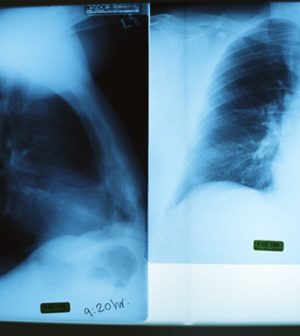- Navigating Your Midlife Crisis: Embracing New Possibilities
- City Raccoons Showing Signs of Domestication
- Mapping the Exposome: Science Broadens Focus to Environmental Disease Triggers
- One Week Less on Social Media Linked to Better Mental Health
- Your Brain Changes in Stages as You Age, Study Finds
- Some Suicide Victims Show No Typical Warning Signs, Study Finds
- ByHeart Formula Faces Lawsuits After Babies Sickened With Botulism
- Switch to Vegan Diet Could Cut Your Greenhouse Gas Emissions in Half
- Regular Bedtime Does Wonders for Blood Pressure
- Dining Alone Could Mean Worse Nutrition for Seniors
Positioning During Cancer Radiation May Be Key to Heart Risks

If you have lung or throat cancer, exactly how you are positioned during your radiation treatments may alter your chances of beating the disease.
New research suggests that even tiny shifts can mean the radiation may harm organs around tumors in the chest, most notably the heart.
“We already know that using imaging can help us to target cancers much more precisely and make radiotherapy treatment more effective,” said researcher Corinne Johnson, a Ph.D. student at the Manchester Cancer Research Center in England.
“This study examines how small differences in how a patient is lying can affect survival, even when an imaging protocol is used,” Johnson explained. “It tells us that even very small remaining errors can have a major impact on patients’ survival chances, particularly when tumors are close to a vital organ like the heart.”
When cancer specialists prepare to perform radiation therapy, they scan the patient’s body to determine the exact position and size of the tumor, the researchers explained. Before every treatment that follows, more images are used to ensure that the patient and the tumor are in the same position.
For the study, the researchers recruited 780 patients undergoing radiation therapy for non-small cell lung cancer. For each treatment, patients were positioned on the machines and an image was taken to ensure they were lying within 5 millimeters (mm) of their original position.
The researchers used the images to assess how precisely the radiation was delivered, and to determine if it shifted closer or farther away from the heart.
The patients whose radiation shifted slightly towards their heart were 30 percent more likely to die than those who experienced a similar shift away from their heart, the investigators found.
When the analysis was repeated with 177 throat cancer patients, the researchers noted an even larger difference — about 50 percent — even after they took other factors, such as the patients’ ages, into account.
The findings were scheduled for presentation Sunday at the European Society for Radiotherapy and Oncology (ESTRO) annual meeting, in Barcelona, Spain. Research presented at meetings should be viewed as preliminary until published in a peer-reviewed journal.
“By imaging patients more frequently and by reducing the threshold on the accuracy of their position, we can help lower the dose of radiation that reaches the heart and avoid unnecessary damage,” Johnson said in a news release from the meeting.
More information
The U.S. National Cancer Institute has more about radiation therapy for cancer.
Source: HealthDay
Copyright © 2025 HealthDay. All rights reserved.










